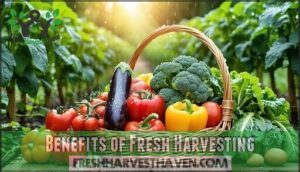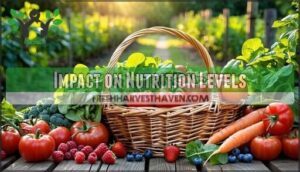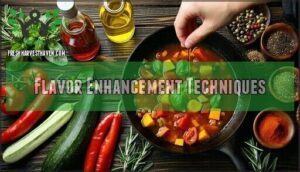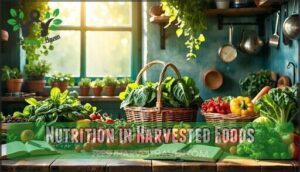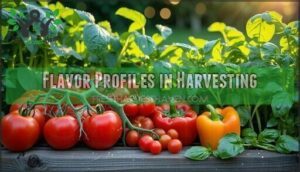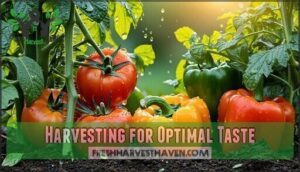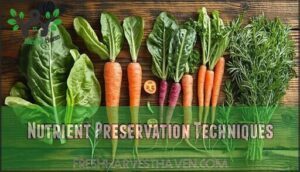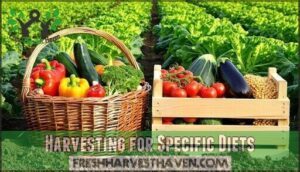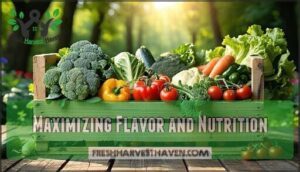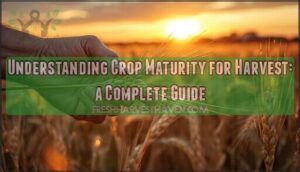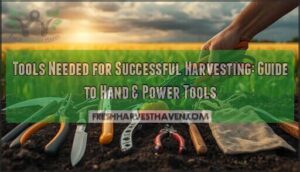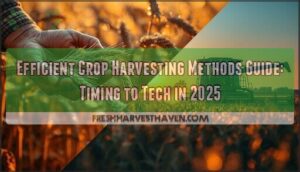This site is supported by our readers. We may earn a commission, at no cost to you, if you purchase through links.
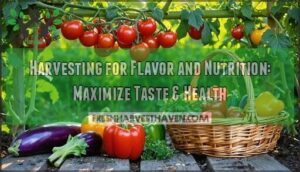 The difference between a sun-warmed tomato plucked from your garden and one that’s traveled cross-country is more than just taste—it’s a nutritional gap you can measure. When you harvest at peak ripeness, you’re capturing enzymes, vitamins, and flavor compounds at their absolute peak, before time and transport steal them away.
The difference between a sun-warmed tomato plucked from your garden and one that’s traveled cross-country is more than just taste—it’s a nutritional gap you can measure. When you harvest at peak ripeness, you’re capturing enzymes, vitamins, and flavor compounds at their absolute peak, before time and transport steal them away.
Most gardeners know their homegrown produce tastes better, but few realize they’re also eating food that’s 15-34% more nutrient-dense than store-bought alternatives. The secret lies in understanding when and how to harvest, then preserving those benefits through smart care.
Master the science of harvesting for flavor and nutrition, and you’ll transform your garden’s bounty into meals that truly nourish.
Table Of Contents
- Key Takeaways
- Harvesting Fresh Produce
- Nutrition in Harvested Foods
- Flavor Profiles in Harvesting
- Harvesting for Optimal Taste
- Nutrient Preservation Techniques
- Harvesting for Specific Diets
- Maximizing Flavor and Nutrition
- Frequently Asked Questions (FAQs)
- How do you harvest food?
- What is the most commonly practiced method of harvesting vegetables?
- What is the easiest food to harvest?
- What are the methods of harvesting fruit?
- Which tools best measure produce freshness at home?
- How does harvesting affect antioxidant content in herbs?
- Are there risks of over-harvesting certain garden crops?
- What pests or diseases impact harvest quality most?
- How does soil quality affect harvested nutrition?
- What are best pre-harvest fertilization practices?
- Conclusion
Key Takeaways
- Harvesting at peak ripeness captures produce that’s 15-34% more nutrient-dense than store-bought alternatives, with vitamins and flavor compounds at their biological prime before degradation begins.
- Post-harvest handling matters critically—cooling produce immediately, avoiding excessive processing, and using proper storage techniques can prevent nutrient losses of up to 88% in some crops.
- Timing your harvest transforms taste and nutrition, as picking at the right moment (like tomatoes at their "breaker stage" or beans when pencil-thin) maximizes both flavor development and nutritional value.
- Smart preservation methods like blanching before freezing, quick dehydration at proper temperatures, and careful canning lock in nutrients and flavor for months, making your harvest’s benefits last well beyond the growing season.
Harvesting Fresh Produce
When you harvest fresh produce matters more than most people realize. The moment you pick a tomato or pluck a berry sets off a chain reaction that affects both its nutritional punch and how it’ll taste on your plate.
Let’s look at what fresh harvesting does for your food, how it impacts the vitamins and minerals you’re getting, and a few smart ways to boost flavor from garden to table.
Benefits of Fresh Harvesting
When you pull fresh produce from the garden at its peak, you’re not just grabbing dinner—you’re capturing vitamins, minerals, and flavor compounds at their absolute best. Here’s why immediate consumption after harvest makes such a difference:
- Peak ripeness locks in maximum nutritional value before degradation begins
- Enhanced enzymes remain active, boosting digestibility and nutrient absorption
- Reduced waste means you’ll eat more of what you grow
- Sensory experience intensifies—taste, aroma, and texture hit harder
- Flavor compounds stay intact, delivering that garden-fresh punch you can’t buy
That’s the real benefit of fresh harvesting: you’re eating produce at its biological prime.
Impact on Nutrition Levels
Nutritional value drops faster than you might think once produce leaves the plant. Post-harvest treatment can wipe out up to 88% of nutrients in some crops, and biofortified varieties lose critical micronutrients like vitamin A and iron when treated poorly. Here’s how to protect what you’ve grown:
- Cool produce immediately to slow vitamin C degradation
- Skip excessive processing—microwaving can destroy 57% of vitamin C
- Choose regenerative practices that boost nutrients by 15-34% from the start
Understanding these nutrient loss factors helps you preserve the nutrition in harvested foods through smart vitamin retention methods. Many consumers find that frozen options increase access to fruits and vegetables.
Flavor Enhancement Techniques
You don’t have to settle for bland produce just because it’s fresh—the right enhancement techniques can intensify the natural flavors you worked so hard to grow. Herb infusions, like basil in olive oil, can brighten your harvest, while spice blends, such as smoked paprika or cumin, add depth.
Cooking methods matter too: quick sautéing or roasting caramelizes sugars and boosts flavor without sacrificing nutrition. Smart flavor pairings and gentle taste manipulation turn good produce into something memorable.
Nutrition in Harvested Foods
You want your harvest to deliver maximum nutrition, but knowing how to preserve those vitamins and minerals isn’t always straightforward. The good news is that a few smart techniques can help you keep more of the good stuff intact from garden to table.
Here’s what you need to know about protecting the nutritional value of your freshly harvested produce.
Vitamin Retention Methods
Ever wonder why that garden-fresh snap fades so quickly? The secret’s in how you treat your harvest—science and timing are your best friends. To lock in Vitamin Retention and keep Maximizing Flavor and Nutrition, rely on:
- Blanching Effects: Stops enzymes cold, preserving vitamins.
- Freezing Impact: Rapid cooling slows nutrient loss, especially with airtight Packaging Types.
- Smart Processing Choices: Flash freezing and vacuum packing extend Storage Duration, keeping Impact on Nutrition Levels high.
Harvesting Fresh Produce demands precision! In fact, canned goods nutrition can be comparable to fresh.
Mineral Preservation Techniques
From the garden to your plate, every step matters for mineral preservation. With water-based cooking, minerals like potassium can slip away—so use the cooking water in soups to keep nutritional value high. Cold storage—especially freezing right after harvest—locks minerals in for months. Non-thermal techniques, such as high-pressure processing, keep minerals stable. Fruit dehydration concentrates minerals, boosting energy density.
Grain refinement strips away iron and zinc, so stick to whole grains for better Impact on Nutrition Levels.
By weaving these Mineral Preservation Techniques into your routine, you’ll truly be Harvesting for Peak Taste.
Healthy Eating Habits
How often do you think about the journey your veggies take from soil to supper, and how those choices shape your everyday health? Healthy Eating Habits start with Mindful Eating and Balanced Diet choices. Try these:
- Plan meals for flavor and nutrition
- Practice Portion Control
- Choose local produce
- Prioritize Hydration Habits
- Snack smart—taste matters!
Flavor Profiles in Harvesting
Flavor in your harvest isn’t just luck—it’s a mix of science and timing. The way fruits and vegetables ripen, balance sugars, and manage acids all play a part.
Let’s look at what shapes their taste as you bring them in from the garden.
Ripening Processes
Think of ripening as your fruit’s backstage transformation—where flavor and nutrition take center stage. In climacteric fruits, ethylene production surges, activating enzymes that soften texture and release sweetness. Non-climacteric types, however, need to stay on the plant to finish the show.
By understanding ripening regulation and post-harvest changes, you can fine-tune your harvesting techniques for fruits bursting with taste, color, and peak nutritional value.
Sugar Content Management
Would you believe that the secret to mouthwatering fruit isn’t just in the sweetness, but in how you manage those sugars from field to fork? Ripening and sugars work hand in hand—enzymes convert starches into sugars, boosting flavor and nutrition.
Sweetness measurement helps you pick at peak sugar content, while sugar metabolism and fruit acidity shape varietal sweetness. For instance, harvesting berries when fully ripe ensures the best sugar conversion.
By understanding ripening processes, you’ll enjoy fruit that’s naturally sweet and balanced, without sacrificing health or flavor. Isn’t nature’s candy worth the wait?
Acid Balance Techniques
Ever notice how a squeeze of lemon can turn a bland dish into something unforgettable? That’s acid balance at work, and it’s just as important in your garden. Flavor balancing starts with managing pH levels and soil acidity. Want to boost sweetness or dial up tartness? Try:
- Regular pH testing
- Compost teas for nutrition
- Microbial activity monitoring
- Balanced soil amendments
Taste and nutrition weave together through smart acid balance techniques.
Harvesting for Optimal Taste
Getting the best taste out of your harvest starts with a few key steps. It’s all about timing, careful treatment, and smart prep.
Here’s what to keep in mind for flavor that really shines.
Timing of Harvest
Isn’t it wild how a single day can mean the difference between bland and exceptional? Timing of harvest is your secret weapon for peak ripeness and prime nutrition.
Harvest timing is your secret weapon—one day separates bland produce from exceptional flavor and peak nutrition
Catch tomatoes at their “breaker stage,” or snap beans when they’re pencil-thin, and you’ll spark flavor development and yield quality. Use your senses—sight and touch—to judge crop maturity.
Smart harvest scheduling assures best harvest time, so you capture the best taste and nutrition before storage impact can steal their magic.
Handling and Storage
After you’ve picked your veggies at just the right moment, how you treat and store them can make all the difference between a crisp salad and a wilted disappointment. Smart treatment and storage protect flavor and nutrition, letting you savor every bite.
Try these five essentials:
- Adjust Storage Temperatures for each crop.
- Choose Container Types that prevent bruising.
- Control Humidity to keep greens perky.
- Separate ethylene gas producers from sensitive items.
- Rotate stock to best preserve shelf life and nutrient preservation.
A little care goes a long way!
Preparation Methods
Once your harvest is safely tucked away, the real fun begins in the kitchen—where a sharp knife and a clean workspace can turn garden bounty into something truly delicious. Good preparation methods start with smart chopping and careful cleaning.
Whether you’re cooking with gentle techniques or enjoying raw consumption, each step matters for flavor and nutrient preservation. Try adapting recipes to highlight fresh flavors and experiment with creative flavor pairings.
Don’t forget to sanitize surfaces for safe culinary uses. With thoughtful prep, you’ll heighten taste and nutrition, letting your harvest truly shine on every plate.
Nutrient Preservation Techniques
Preserving nutrients after harvest is all about using the right techniques. The way you treat your produce can make a real difference in taste and health benefits.
Here’s a look at some trusted methods to help you lock in both flavor and nutrition.
Cooling and Freezing
Amid harvest season, cooling and freezing step in as unsung heroes for flavor and nutrition. Quick chilling halts enzyme activity, preserving nutrients and keeping produce crisp. Flash freezing locks in taste and texture, so your frosty berries and garden tomatoes stay vibrant. Blanching before freezing boosts nutrient retention and curbs texture changes. With proper storage, these nutrient preservation techniques transform food preservation into a year-round pantry win.
Imagine:
- Frosty berries ready for breakfast
- Crisp, cold tomatoes for salads
- Summer herbs saved for winter stews
- Frozen meals echoing farm-fresh flavor
Dehydration Methods
If you’re looking for a way to keep your garden flavors handy without filling up the freezer, dehydration is your ticket to lightweight, shelf-stable goodness. By dialing in proper dehydration temperatures, you lock in nutrient density and crank up flavor concentration.
Whether you use sun drying, a food dehydrator, or freeze drying, each method offers unique storage solutions for your harvest.
When you’re ready, rehydration techniques bring those intense flavors back to life, perfect for soups, stews, or trail snacks.
Canning and Pickling
When the garden bounty starts piling up, canning and pickling step in as your flavorful ticket to preserving memories and nutrition for months to come. You’ll boost shelf life and reveal creative recipe variations. For safe, tasty results, remember:
- Prioritize canning safety.
- Experiment with pickling brines.
- Explore fermented foods.
- Share harvest preservation tips for food safety.
Harvesting for Specific Diets
Harvesting with your dietary needs in mind can make all the difference in taste and nutrition. Whether you’re vegan, gluten-free, or have special requirements, the right approach matters.
Let’s look at how to tailor your harvest for your specific goals.
Vegan and Vegetarian Options
Ever notice how a plate full of vibrant veggies can turn an ordinary meal into a celebration of flavor and culture?
With ethical harvesting and dietary diversity, you get plant-based protein, vegan micronutrients, and vegetarian iron—all packed into vegan options and vegetarian delights.
Meat alternatives like tofu and seitan bring global flair, making every bite both nourishing and adventurous.
Gluten-Free and Low-Carb
Though bread might be off the table, there’s a whole world of garden-fresh veggies ready to make gluten-free and low-carb eating both delicious and satisfying. Want to get the most flavor and nutrition? Try these five tips:
- Harvest at peak ripeness for best taste.
- Choose Grain-Free Swaps like cauliflower.
- Focus on Diabetic-Friendly Harvest picks.
- Embrace Keto Harvesting with non-starchy veggies.
- Experiment with Meat Alternatives for Gluten-Free Flavor.
Special Dietary Needs
Addressing special dietary needs is a bit like solving a tasty puzzle—every ingredient choice brings you closer to meals that fit just right. Think allergen-free harvesting for peace of mind, diabetic-friendly options for balanced sugar, and low-sodium harvests for heart health.
High-fiber choices and gut-friendly produce keep your system happy. With smart picking, you can boost flavor, nutrition, and taste—even if gluten-free or other needs guide your harvest.
Maximizing Flavor and Nutrition
If you want the best flavor and nutrition from your harvest, timing and technique matter more than you think. There are plenty of ways to get the most out of your garden, no matter what or when you’re picking.
Let’s look at some practical options that can help you enjoy every bite.
Seasonal Harvesting
Nature doesn’t hand out flavor and nutrition all year—timing your harvest with the seasons is like catching the best wave for surfers: it’s where freshness and quality peak.
Climate impact, soil influence, and weather effects shape crop timing and regional variations, so seasonal harvesting lets you ride nature’s rhythm for produce that’s bursting with taste and loaded with nutrition.
Local and Organic Options
Choosing local and organic options is like tapping directly into your garden’s potential—fresher, more flavorful, and packed with nutrition. Understanding consumer awareness around sustainable farming helps you make smarter choices that benefit both your health and the environment.
- Organic Farms follow strict organic standards, avoiding synthetic pesticides while enhancing flavor complexity.
- Local Benefits include shorter transit times, preserving peak nutrition and taste.
- Community Gardens connect you to sustainable farming practices and fresher harvests.
- Reduced carbon footprint aids eco-friendly food systems.
- Seasonal availability from local sources ensures prime ripeness and nutrient density.
Creative Recipe Ideas
Once you’ve sourced the freshest local and organic produce, the real fun begins—turning that bounty into meals that make your taste buds (and body) genuinely happy. Think beyond basic salads—try herb infusions in sparkling water, vibrant fruit salads with unexpected spice pairings, or vegetable medleys roasted to caramelize natural sugars. Pickling recipes and fermented dishes add probiotic punch while extending shelf life. These culinary techniques reveal layers of flavor and nutrition you won’t find in store-bought versions.
| Dish Type | Key Ingredients | Flavor Boost |
|---|---|---|
| Herb Infusions | Basil, mint, cucumber | Citrus zest |
| Fruit Salads | Berries, stone fruits | Honey, lime |
| Vegetable Medleys | Root vegetables, squash | Garlic, rosemary |
Your garden’s taste potential is limitless when you experiment boldly.
Frequently Asked Questions (FAQs)
How do you harvest food?
The best harvest happens before you even start—it’s all in knowing when to stop.
You’ll want to pick produce at peak ripeness, using clean hands or sharp tools to snip stems gently rather than yanking or bruising. Harvest during cooler morning hours to preserve nutrients and flavor.
What is the most commonly practiced method of harvesting vegetables?
Hand harvesting remains the most common method for vegetable harvesting techniques. You’ll select crops at their ideal harvest time, then carefully snip, twist, or pull them from the plant.
This manual harvesting approach lets you assess ripeness and minimize damage better than mechanical harvesting.
What is the easiest food to harvest?
Leafy lettuce leads the list for beginner crops seeking quick harvests with minimal effort. You’ll simply snip outer leaves when they’re palm-sized, leaving the center to keep producing—no digging, no special tools required.
This cut-and-come-again technique delivers high yield throughout the growing season, making vegetable harvesting ridiculously simple even at your ideal harvest time.
What are the methods of harvesting fruit?
Fruit harvesting methods vary by type, but most involve hand-picking at peak ripeness. Watch for color changes, firmness, and aroma.
Use sharp pruners for stems to prevent damage, treat gently to avoid bruising, and cool quickly post-harvest to preserve sugar content and slow the ripening process for best flavor and nutrition.
Which tools best measure produce freshness at home?
A kitchen scale tracks weight loss (a freshness red flag), while a digital thermometer ensures proper storage temperatures.
For the adventurous, a refractometer measures sugar content—your ripeness indicator for peak taste.
These Home Testing Kits turn Sensory Evaluation scientific, helping you nail Harvest Timing and flavor at home.
How does harvesting affect antioxidant content in herbs?
When you harvest herbs, their antioxidant content starts declining immediately—especially under heat or rough treatment. To preserve these compounds, pick early morning when oils peak, treat gently, and cool quickly in shade or refrigeration.
Are there risks of over-harvesting certain garden crops?
Think of asparagus spears snapping cleanly at dawn—you can definitely over-harvest perennials and damage their future productivity.
Garden crops like asparagus, rhubarb, and herbs need recovery time between cuttings to rebuild root reserves, preventing plant stress and reduced yields while maintaining sustainable practices for your ecosystem.
What pests or diseases impact harvest quality most?
Aphids, spider mites, and powdery mildew can devastate your crops—stunting growth and sapping nutrients. Catch these troublemakers early through careful pest identification, then use organic controls and crop rotation.
Disease prevention with resistant varieties keeps your harvest flavorful and nutritious.
How does soil quality affect harvested nutrition?
Soil nutrient density directly determines the nutritional value of your harvest—plants can only absorb what’s available in the soil.
Rich organic matter and balanced pH improve mineral uptake efficiency, while a healthy soil microbiome helps convert nutrients into forms plants can actually use.
What are best pre-harvest fertilization practices?
Pre-harvest fertilization works best when you time nutrient applications 4-6 weeks before picking. Soil testing guides organic fertilizers selection, correcting deficiency while boosting nutritional value.
This nutrient timing improves flavor through proper sugar content management and acid balance techniques.
Conclusion
Perfect produce starts with precision—planting, patience, and proper harvesting for flavor and nutrition. You’ve learned that timing transforms taste, that every hour post-harvest matters, and that preservation techniques lock in what nature gave you.
Now it’s your turn to wield those garden shears with intention. Harvest when the science says so, treat with care, and watch your kitchen become a symbol to what real food should be—vibrant, alive, and truly nourishing.
- https://pmc.ncbi.nlm.nih.gov/articles/PMC11545078/
- https://www.agriculturejournal.net/archives/2025/vol7issue8/PartB/7-8-13-527.pdf
- https://bepls.com/bepls_oct_2018/29.pdf
- https://www.nature.com/articles/s41598-025-11680-w
- https://www.frontiersin.org/journals/sustainable-food-systems/articles/10.3389/fsufs.2024.1425599/full

